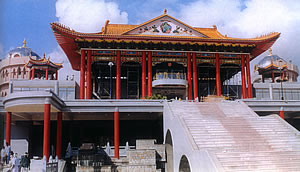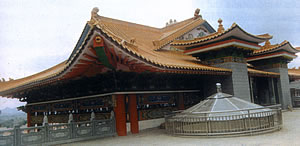

Facets of Divine Construction - Chaitanya Jyothi
by Col. S.K. Bose (Rtd.) Trust Engineer

![]() This
building was constructed to commemorate the 75th Birthday of Bhagawan
Sri Sathya Sai Baba and houses an exhibition on His Life and Mission.
The location was selected keeping in view the ambience and grandeur of
the structure. A level site of 65 m frontage and 60 m depth and 4 m above
road level had to be created out of a sloping hillside. This entailed
3 to 4 m of filling to an extant of one third portion and about 5,000
m3 of rock removal on the remaining portion. The building is 23 m high,
with a covered area of about 6,000 m2. The apex of the roof is 27 m high
from the road level.
This
building was constructed to commemorate the 75th Birthday of Bhagawan
Sri Sathya Sai Baba and houses an exhibition on His Life and Mission.
The location was selected keeping in view the ambience and grandeur of
the structure. A level site of 65 m frontage and 60 m depth and 4 m above
road level had to be created out of a sloping hillside. This entailed
3 to 4 m of filling to an extant of one third portion and about 5,000
m3 of rock removal on the remaining portion. The building is 23 m high,
with a covered area of about 6,000 m2. The apex of the roof is 27 m high
from the road level.
The architect, Goh Say Tong of Malaysia, designed a unique structure with a fusion of many cultures and architectural styles. A roof similar to a Chinese Emperor's Palace, flanked by two Moorish domes made of titanium, crowning semicircular ends adorned with gothic arches, are the main features. The two lift shafts have Japanese style roofs and there is a fish pool in front, designed by a specialist from Singapore. The stone balustrades and the front sthupa came from China. Incidentally, this is the biggest Chinese roof outside mainland China.
 The
excavation which started on 16th November 1999 was completed in April
2000, because this involved hard rock profiles. In order to accelerate
the excavation progress, a rock breaker was employed. It was withdrawn
a month later being unable to break the hard granite strata underlying
the top layer. Permission was then given for controlled blasting, which
commenced on 3rd February 2000 and went up to 20th April 2000.
The
excavation which started on 16th November 1999 was completed in April
2000, because this involved hard rock profiles. In order to accelerate
the excavation progress, a rock breaker was employed. It was withdrawn
a month later being unable to break the hard granite strata underlying
the top layer. Permission was then given for controlled blasting, which
commenced on 3rd February 2000 and went up to 20th April 2000.
Because of the stringent time schedules, the structural construction did not proceed in the normal way but commenced wherever site clearance was made available. Thus on the right hand side the columns and slabs were raised up to the roof level, leaving dowels. All levels were tackled simultaneously and the whole building was constructed proceeding sideways from right to left. This radical departure from normal construction sequence was adopted, in order to meet the stringent time frames and to make the building functional.

![]() Yet
another innovation includes anchoring the reinforcement bars of columns
directly into the hard granite rock wherever such rock was encountered.
M 30 grade concrete was adopted and used for all structural members. For
intermediate slabs and heavily reinforced beams, w/c ratio of 0.38 was
adopted using Fosroc Conplast SP 337 superplasticiser. For all slabs open
to sky and the Chinese roof slab, w/c ratio of 0.36 with maximum superplasticiser
dosing was adopted. Joints in slabs were kept to a bare minimum and wherever
joints had to be provided, epoxy based bonding chemical was used to ensure
the best possible bonding. No leakage or seepage has ever been noticed.
In order to ensure proper curing, pounding for 28 days and column cured
slabs and beams were cured using Fosroc WB water based membrane curing
compound. For maintaining proper curvature of the Chinese Roof and Gazebos,
templates were used and finished surfaces matched exactly with the drawings.
Maximum care was taken to maintain straight lines on the exterior finishes.
To maintain uniformity, all mortar for plaster was mixed in concrete mixers.
Yet
another innovation includes anchoring the reinforcement bars of columns
directly into the hard granite rock wherever such rock was encountered.
M 30 grade concrete was adopted and used for all structural members. For
intermediate slabs and heavily reinforced beams, w/c ratio of 0.38 was
adopted using Fosroc Conplast SP 337 superplasticiser. For all slabs open
to sky and the Chinese roof slab, w/c ratio of 0.36 with maximum superplasticiser
dosing was adopted. Joints in slabs were kept to a bare minimum and wherever
joints had to be provided, epoxy based bonding chemical was used to ensure
the best possible bonding. No leakage or seepage has ever been noticed.
In order to ensure proper curing, pounding for 28 days and column cured
slabs and beams were cured using Fosroc WB water based membrane curing
compound. For maintaining proper curvature of the Chinese Roof and Gazebos,
templates were used and finished surfaces matched exactly with the drawings.
Maximum care was taken to maintain straight lines on the exterior finishes.
To maintain uniformity, all mortar for plaster was mixed in concrete mixers.
 Filling
in plinth was done using alternate layers of rock and murrum and compacted
by a plate vibrator. The fill portion of the road was initially compacted
by a vibratory roller and later by a conventional road roller.
Filling
in plinth was done using alternate layers of rock and murrum and compacted
by a plate vibrator. The fill portion of the road was initially compacted
by a vibratory roller and later by a conventional road roller.
Flooring required a wide variety of materials to be used, such as ceramic tiles, polished granite tiles of grey/red colour and of different tiles - like Jaisalmer marble tiles and white glazed tiles. Because of the coarse sand available in the area, the plastered surface had to be treated with plaster of paris and applied with acrylic emulsion paint. The external surface was treated with the Heritage (granite) surfacing system and a pattern was created to stimulate granite masonry. Extensive stapathi work was done on flat surfaces to improve aesthetics. The structure is lit, for most part, by halide lamps of Thorn make. Fiber optic lights under the Chinese roof enhance the beauty of the decorative reflected ceiling.
The edifice is something that all those connected with the construction can be proud of. The unique building, now named Chaitanya Jyoti, was inaugurated on 18th November 2000 by Bhagawan Sri Sathya Sai Baba.